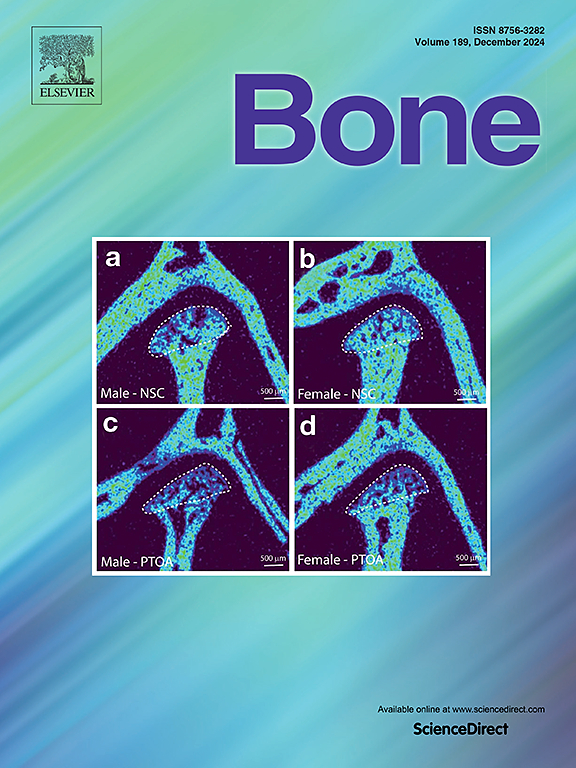Statistical shape modelling of the first carpometacarpal joint: A cross-sectional analysis of an osteoarthritis initiative cohort
IF 3.6
2区 医学
Q2 ENDOCRINOLOGY & METABOLISM
引用次数: 0
Abstract
Introduction
Statistical shape modelling (SSM) has been used extensively to investigate the relationship between joint shape and hip, knee and spine osteoarthritis (OA), but first carpometacarpal joint (CMCJ) shape and thumb base OA is less understood. We established a statistical shape model of the first CMCJ to investigate the ability of SSM to evaluate CMCJ morphology and determine its ability to investigate association with thumb base OA.
Methods
100 participants' bilateral hand and wrist radiographs were selected at random from the OAI database. A model was developed using SSM software to characterise first CMCJ shape and applied to radiographs. Radiographic OA severity was graded using Kellgren-Lawrence. Independent modes of variation in shape within the cohort were identified. Relationship with clinical symptoms and radiological severity was assessed using multivariate regression models adjusted for age, sex, height and weight.
Results
Ten and nine modes of variation were identified in right and left models respectively. Concurrent ipsilateral hand pain and stiffness was associated with right-mode-1 (RM1) (multivariate model, co-efficient 0.104, 95 % CI 0.011–0.197, p = 0.028), which anatomically represents greater prominence of ulnar aspect of trapezium joint surface. Stratified radiological OA severity showed CMCJ severity was associated with RM1,6,10 and LM 1,6,7 and STJ severity was associated with RM1 and LM1,6,7.
Conclusions
We demonstrate the application of SSM in a novel context, showing its ability to evaluate variation in CMCJ morphology from radiographs. This study identifies and justifies the requirement for novel automation techniques in SSM to facilitate longitudinal studies required to investigate clinical applications.
第一腕掌关节的统计形状建模:一项骨关节炎初始队列的横断面分析。
统计形状模型(SSM)已被广泛用于研究关节形状与髋关节、膝关节和脊柱骨关节炎(OA)之间的关系,但第一腕骨关节(CMCJ)形状与拇指基部OA的关系尚不清楚。我们建立了第一个CMCJ的统计形状模型,以研究SSM评估CMCJ形态的能力,并确定其研究与拇指基部OA相关的能力。方法:从OAI数据库中随机抽取100例受试者的双侧手和腕关节x线片。使用SSM软件开发了一个模型来表征第一个CMCJ形状,并应用于x光片。采用Kellgren-Lawrence对骨性关节炎严重程度进行影像学分级。确定了队列中形状变化的独立模式。采用多变量回归模型对年龄、性别、身高和体重进行校正,评估临床症状与放射学严重程度的关系。结果:左、右模型分别鉴定出10种和9种变异模式。同时发生的同侧手部疼痛和僵硬与右模式-1 (RM1)相关(多变量模型,系数0.104,95 % CI 0.011-0.197, p = 0.028),解剖学上代表了更突出的斜方关节面尺侧。分层放射学骨性关节炎严重程度显示,CMCJ严重程度与RM1、6、10和LM1、6、7相关,STJ严重程度与RM1和LM1、6、7相关。结论:我们展示了SSM在一个新的背景下的应用,显示了它从x线片评估CMCJ形态变化的能力。本研究确定并证明了在SSM中对新型自动化技术的需求,以促进调查临床应用所需的纵向研究。
本文章由计算机程序翻译,如有差异,请以英文原文为准。
求助全文
约1分钟内获得全文
求助全文
来源期刊

Bone
医学-内分泌学与代谢
CiteScore
8.90
自引率
4.90%
发文量
264
审稿时长
30 days
期刊介绍:
BONE is an interdisciplinary forum for the rapid publication of original articles and reviews on basic, translational, and clinical aspects of bone and mineral metabolism. The Journal also encourages submissions related to interactions of bone with other organ systems, including cartilage, endocrine, muscle, fat, neural, vascular, gastrointestinal, hematopoietic, and immune systems. Particular attention is placed on the application of experimental studies to clinical practice.
 求助内容:
求助内容: 应助结果提醒方式:
应助结果提醒方式:


